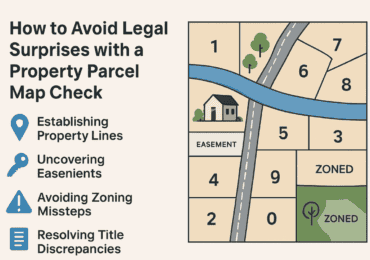Property ownership or development involves a complex process. The parcel map check is a key area of focus that is regularly disregarded, and this professional resource is not only instrumental in avoiding costly legal complications but also beneficial to the buyer in the property transaction process. In this article, we will discuss how an in-depth parcel map check can save you years of legal battles.
Understanding Parcel Maps
Parcel maps are schematics of how the land is subdivided—boundaries, easements, dimensions of properties, etc. A property parcel map provides vital information to property owners about their holdings and can help identify potential legal disputes before they escalate into larger problems.
Establishing Property Lines
Property boundaries are significant because they mark the extent of ownership. Well-defined boundaries provide clear property descriptions, reducing the chances of potential disagreements with neighbors. This, in turn, lessens the likelihood of owners encroaching on the property’s trace. A parcel map examination clarifies these dividing lines. This ensures that you know exactly where your property ends and your neighbor’s property begins—an invaluable asset when planning where to place a fence or prepare for a construction project.
Uncovering Easements
Easements are rights given to others to use part of your property for a specific purpose, such as utility lines, road access, or shared pathways. Parcel maps provide information on existing easements, allowing property owners to understand their obligations fully. Being aware of these rights allows us to avoid unintentionally violating agreements on our properties and helps maintain positive relationships with our neighbors.
Avoiding Zoning Missteps
Zoning laws regulate what land uses are allowed and prohibited within a parcel of land. Breaching these laws can lead to expensive fines or legal disputes. A parcel map check ensures that property owners are following local zoning ordinances. Such knowledge guarantees that developments align with community standards and that legal landmines are averted.
Resolving Title Discrepancies
Ownership issues or monetary responsibility can arise due to erroneous records or older transactions. Most of those issues can be resolved through a parcel map check before they become larger problems. Tackling these problems upfront avoids the possibility of legal headaches down the road.
Boundary Conditions
Environmental constraints, including wetlands or protected habitats, can severely restrict development possibilities. These are areas that parcel maps will often indicate, offering valuable insight for future planning. Knowledge of environmental limitations can avert expensive project delays or fines and promote responsible land use.
Getting Ready for Future Development
Acquainting oneself with the arrangement of a property and its limitations enhances development planning. Performing a full parcel map check can offer architects and planners insights for informed decisions on where to place or expand buildings. The reduction of costly mistakes helps ensure that projects are completed on time and in compliance with local laws.
Verifying Legal Documents
A property transaction involves several legal documents, all of which need to be precise. This accuracy must be compared with parcel maps to ensure consistency. Discrepancies between legal descriptions and maps can lead to litigation. Clarifying these details early prevents complications and enables a seamless transaction.
Making the Sales Process Easier
Potential buyers want to be certain about property lines, easements, and zoning compliance. Parcel map checks provide the transparency needed to build trust during real estate transactions. Clear documentation can speed the sales cycle, benefiting both buyers and sellers. With all expectations set in advance, there’s less chance of disputes after the sale, resulting in greater satisfaction overall.
Grasping the Context of the Times
Parcel maps can reveal when a property was built. A solid understanding of land divisions or previous ownership offers clues to current or future issues or opportunities. This historical perspective is especially valuable for investors who are looking to renovate or update older structures. Understanding historical land use can inform future decisions and help avoid repeating past mistakes.
Enhancing Community Relations
Good parcel maps not only serve individual properties but also help keep communities aligned. Living next to someone who may have active or future easements on your property can be challenging unless you know the exact property lines and the rights involved. Residents also become aware of what behaviors are acceptable within their neighborhood, preventing unnecessary conflict due to misunderstandings, especially for new families moving in.
Conclusion
Proactive property management is key to avoiding legal surprises. This process requires a comprehensive parcel map check. Property owners can navigate potential pitfalls through knowledge of boundaries, easements, zoning laws, and environmental restrictions. Such active vigilance facilitates transactions, protects investments, and contributes to peace of mind, ultimately leading to more harmonious communities overall.
